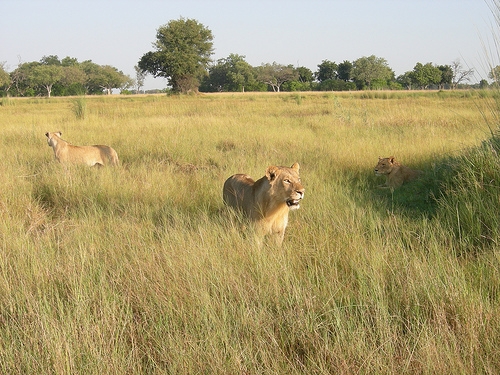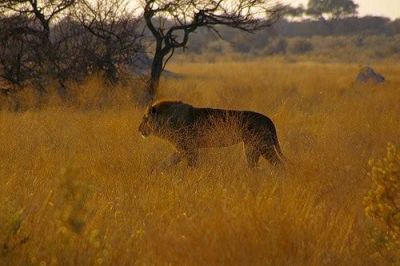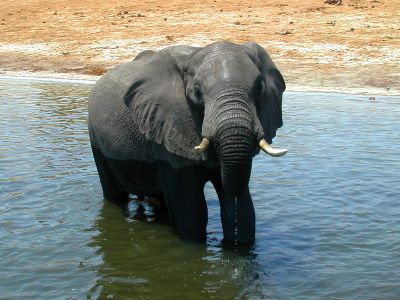The post What It’s Like The First Time You Spot A Lion In Africa appeared first on The Expeditioner Travel Site.
]]>
One of the sad parts about going on safari is the speed at which you become desensitized to what would otherwise be an incredible viewing experience anywhere else in the world. For example, during my own mini-safari in South Africa’s Kruger National Park, the first animal my small group encountered was a small gathering of impala — a medium-sized antelope originating from the continent of Africa. All of us clambered to the edge of the vehicle with cameras in tow to capture their image for the next 10 minutes while our driver sleepily slunk into his chair, enjoying a few moments of rest during this ungodly early hour of the morning.
What he knew, and what we’d find out soon enough, is that the impala in Kruger is what the pigeon is to New York City. In other words, not much to get worked up about, as we were about to encounter impala basically everywhere we went, including our campsite, during our game drives, near the restaurant where we would have lunch and pretty much anywhere else we went in search of other animals.
However, of the other animals we encountered — giraffes, wildebeests, cape buffalos, grey and white rhinos, elephants, bats, hyenas — the one animal we nor anyone else I knew never got tired of seeing was the lion. In fact, one finds that much of their day is spent in search of lions, with guides radioing each other as to their last sighting, park maps with magnetic markers indicating recent viewings, and even the occasional traffic jam as multiple vehicles bottleneck on the same narrow roadway as a lion or two is spotted.
The Sydney Morning Herald recently went on safari to Botswana’s Okavango Delta, a region famed for its wildlife offerings. Undoubtedly, the delta is one of the premier spots in Africa to go on safari.
Unlike some of its neighbours, Botswana has pursued a low-impact, high-cost approach to tourism. The Okavango Delta operates like a big nature reserve. There are about 60-odd camps in the 17,000-square-kilometre area and any safari operator who obtains a permit is only allowed to build semi-permanent structures that can be dismantled in a day or two.
In Africa, water equals animals, so naturally the Okavango Delta is a premier spot to see all sorts of wildlife. And like true love and one’s first encounter with the Shamrock Shake, your first encounter with a lion is truly a memorable experience, as the author recounts. “The spell that seemed to come over me during the encounter is broken. I breathe easily again. This is my first meeting with the king of the jungle in the wild and although it lasts only a few minutes, I am overwhelmed. I am in Africa, I am in the midst of nature’s stunning creations, and I feel alive in a way I have never felt before.”
My own encounter included a mother with six cubs whom we ran into every day in the morning as she led her cubs on morning hunts. Sadly enough, by the last day, the number of her cubs had been reduced to five, with no indication of what happened to the sixth sibling. Heartbreaking, yes, but this is Africa in its truest form.
[Okavango Delta by Joachim Huber/Flickr]
The post What It’s Like The First Time You Spot A Lion In Africa appeared first on The Expeditioner Travel Site.
]]>The post Video: Wonder What It’s Like To Safari In Botswana? appeared first on The Expeditioner Travel Site.
]]>As many of you knew, I was tentatively planning on heading out to Africa for a 14-day safari with a friend of the site, Dan of Grass Track Safaris, but the timing ended up not working out so I had to go it alone. Anyway, Dan got back safely from the continent and had some time to put together some footage of what I missed out on. (He’s also beaten me to the punch by at least a few weeks regarding an Africa travel video.)
This clip follows the group as they head from Victoria Falls, through Chobe, and into the Okavango Delta. As far as wildlife goes, I have to say I’m especially jealous of the fact that there’s not one but two shots of leopard (1:25 and 2:30) in the vid (I had zero on my safari).
Also, nice choice of Amadou & Mariam for the music in the background, by far my favorite blind duo musical act from Mali, and I don’t say that very often.
The post Video: Wonder What It’s Like To Safari In Botswana? appeared first on The Expeditioner Travel Site.
]]>The post “Hunting” For Lions In The Botswana Bush appeared first on The Expeditioner Travel Site.
]]>
On safari in the Botswana bush in search of the elusive lion.
By Danielle Max
Modern hunters may shoot with cameras and not guns, but the adrenalin rush when the “prey” comes into view remains, as I discovered when I went in search of the elusive lion in Botswana. While elephants thrive in great numbers, I learned that spotting the big cats takes perseverance, endurance and, more than anything else, a whole lot of luck.
After nearly an hour of driving along rutted paths and seeing little more than a few birds and some wandering antelope — all of which I had nevertheless diligently ticked off in my safari guide: “Northern Botswana, Eastern Caprivi and Zambezi River” — Michael, my guide, finally saw what we’d been looking for. “Look, fresh lion tracks,” he said, leaning out of the side of our truck and pointing to the sandy road below. “Looks like they passed by here very recently.”
This was the final drive of my trip and it was exactly what I had come to Botswana to see. I rushed to the opposite side of the vehicle to study the footprints in the sand. While I, a mere novice, could barely make out the faded prints, an expert like Michael could read them as clearly as if following signs on a highway. After much patient gesticulating and pointing, we began to drive slowly forward and I followed the tracks as they made their way down the road.
Abruptly, Michael brought the vehicle to a sharp stop, the wheels sending up plumes of sand particles. “Can you see?” he asked excitedly, pointing to what appeared to me as a patch of earth indistinguishable from the other miles of earth surrounding it. “This is where the lion lay down.” To the untrained eye, there was a slight smudging in the tracks, but listening to Michael’s explanation made it easy to imagine where the lion, tired from its hunting, had spied a slight groove in the road and lay down, giving its weary feet some rest.
I looked around, naively hoping the lion would be visible from the truck. Michael turned to me, shook his head and said with evident disappointment that the lion had skulked off into the bush and away from prying eyes — and in Africa, there is a lot of bush to choose from for a lion.
Located in the northeastern corner of the southern African country of Botswana, Chobe National Game Park is the second largest game park or reserve in the country. The most common way to cover the 600 miles from the capital Gaborone — known as Gabs City to the locals — is by air, in and out of Kasane Airport, located directly next to the reserve. Botswana has been experiencing an upsurge in visitors in recent years, some of which as a result of the success of Alexander McCall Smith’s best-selling series of books set in Gaborone about the Number One Ladies’ Detective Agency (soon to be a series on HBO and BBC).
 While the lion may be the king of the jungle everywhere else, in Chobe the elephants call the shots. In contrast to lions, whose numbers are lamentably low — partly because of their culling by farmers eager to protect their livestock — elephants abound in great herds. With an estimated 120,000 of these gigantic quadrupeds stamping around the park, they’re hard to miss.
While the lion may be the king of the jungle everywhere else, in Chobe the elephants call the shots. In contrast to lions, whose numbers are lamentably low — partly because of their culling by farmers eager to protect their livestock — elephants abound in great herds. With an estimated 120,000 of these gigantic quadrupeds stamping around the park, they’re hard to miss.
When they are not feeding — which, as I learned, they do for up to 16 hours a day — elephants love to bathe. During the day, they run down to the Chobe River in droves to drink the water and to cool off when the African sun begins to throb in earnest. Once they’ve splashed around and drunk their fill, the elephants take a mud bath, which acts as both a sunblock as well as an insect repellent.
Other species also roam in great numbers, one of which is the comical yet beautifully colored guinea fowl that spend almost all of their lives on the ground, awkwardly taking flight only when in imminent danger. Impala also wander in vast packs. These antelope display no fear of oncoming vehicles and they tend to run across the roads with abandon, which probably explains why so many game lodges list impala on their menus.
Still looking for big cats, Michael and I continued to traverse the park as I crossed off giraffes and zebras in my field guide. Just when I began to give up hope of seeing any large cats, an excited call came over the radio. Much to my consternation, it was not a lion spotting but a sighting of the reserve’s only pack of wild dogs.
Although wild dogs may not have the prestige of the big five, I learned that they are incredibly rare; Michael had not seen this particular pack of dogs for more than four months. Just as farmers have reduced the numbers of lions, they have also thinned out the wild dog population. They know all too well that unchecked, the canines will make their way beyond the borders of the national park in the hopes of an easy, and tasty, meal of their valuable cattle.
When we first saw the dogs, they were little more than specks on the horizon. Whereas before we’d been alone — creating the illusion we had the bush to ourselves — our truck was now joined by half a dozen other packed vehicles that had gathered to watch this rare sight.
The dogs came near enough for us to be able to count them, then they headed down to the distant river — though, curiously, not to get a drink. The pack was intently looking out over the water. Michael scoped the landscape and soon caught site of what was holding the dogs’ attention: a dead buffalo lay on the other side, its pungent scent drifting over the water, exciting the dogs.
Once they realized the meat was inaccessible, the dominant male led the group up from the bluffs. The dogs, which looked very similar to German Shepherds, bounded up close to idling cars. Paying little attention to their audience, they crossed the road and went off in search of nearer and fresher prey than the long-dead buffalo.
As the dogs moved off into the distance, Michael revved up the engine and we moved on again, still in search of lions. We headed down to the riverbed where we saw hundreds of zebra, but they were a ways off, practically on the far side of the river.
Their distance from the road spoke to Michael’s tracking expertise and he immediately began reading the ground. Once again, he pointed to some lion tracks and explained that the predator was still somewhere in the vicinity. This, he said, explained why the zebra were so far away and why the impala, which were closer to us than the zebra, were standing stock-still while straining to assess the likely danger. Only a lone warthog carried on nonchalantly; eating away, seemingly oblivious to the fact that he could be dinner for a hungry cat.
Following the fresh footprints, my increasingly excited game driver flagged down a car coming from the other direction and asked its occupants if they had seen anything interesting. “Only a herd of buffalo,” said the driver, leading to yet another wave of disappointment.
Undeterred, Michael pursued the trail a few hundred feet up the road. Suddenly, out of the corner of his eye, he spotted something. He immediately threw the car into reverse and there it was: a large male lion sitting under a bush right by the side of the road. I held my breath, afraid of doing anything to cause him to run away. I instinctively reached for my camera. After a long morning of searching in vain, our mission was accomplished just as we were getting close to turning around. The lion poked his head up and took a long, hard look at us. Just as Michael began to creep the truck forward and into a better position, the lion decided it was not a day for pictures and he gracefully leapt to his feet, shook the dirt from his coat, and retreated into the dense scrub and out of our sight, all before I could get a single shot off.
Our morning-long hunt was over in little more than a few moments. After searching for the lion for so many hours, getting so close yet barely seeing him for more than a few seconds seemed a little frustrating at the time. Still, I reasoned with myself, as Michael shifted the truck back into gear, at least I had been lucky enough to get a brief, privileged view of the king of cats on his natural throne. More than that, I had managed to cross off a certain, elusive box in my faithful field guide that morning, as well as to capture a few images in my mind that I’m certain to never forget for the rest of my life.

The post “Hunting” For Lions In The Botswana Bush appeared first on The Expeditioner Travel Site.
]]>